From a tragic PlayPlace death to a McRib made of kangaroo meat, McDonald’s rumors range from wild urban legends to real stories
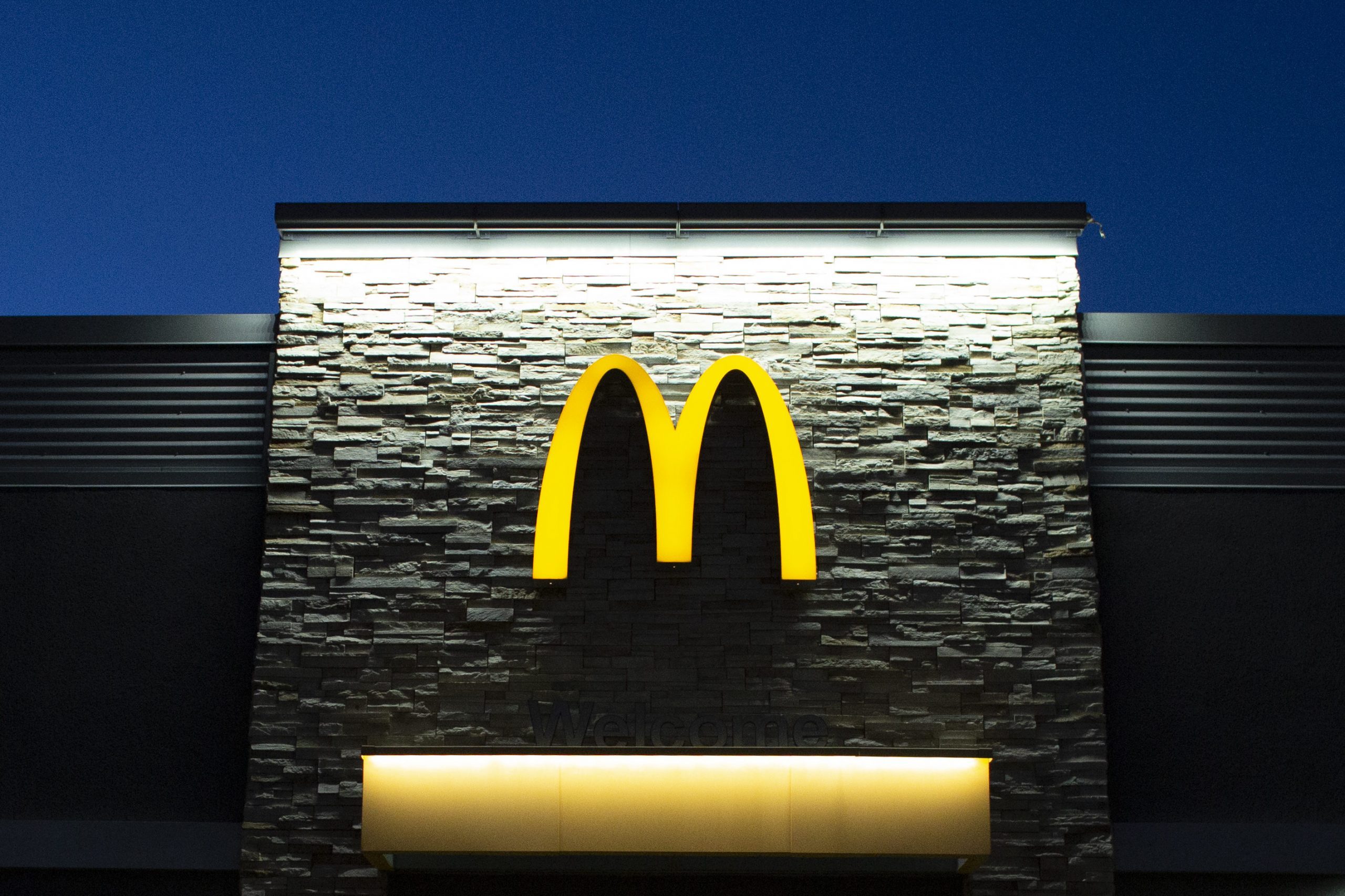
11 Popular McDonald’s Rumors—And If They’re Really True


Two all-beef patties
Rumor: McDonald’s beef patties are made with pink slime.
Fact-check: False
The McDonald’s pink slime controversy is a quintessential example of the internet running wild with a disturbing food origin story. Between 2009 and 2012, a picture of a slimy pink substance in a small cardboard box began making rounds online, and the gross-looking suspected meat product was quickly linked to McDonald’s.
For starters, pink slime is real. It’s what happens when meat is “mechanically processed” to help remove the edible parts from the bones—so that less goes to waste—and then (sometimes) treated with antimicrobial ammonia. This lean, finely textured beef was not only deemed safe to consume by the Food and Drug Administration (FDA) and the U.S. Department of Agriculture (USDA) when this McDonald’s rumor erupted, but it was also used by other food retailers.
In 2011, McDonald’s confirmed that it no longer uses lean beef trimmings, aka “pink slime,” because the company aims to “be consistent” across its global beef supply chain. The McDonald’s pink slime controversy cropped up again in 2017 but was fact-checked by the Associated Press. “Some consumers may be familiar with the practice of using lean, finely textured beef sometimes treated with ammonia, which is referred to by some as ‘pink slime.’ We do not use this,” McDonald’s FAQ page confirmed in 2021.
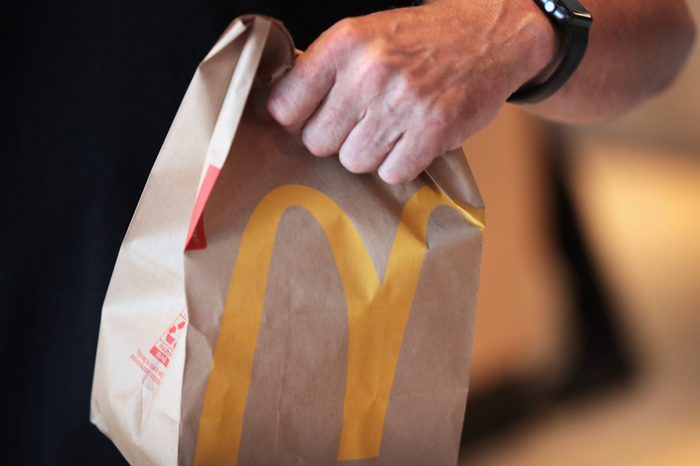
That ’90s seaweed sandwich
Rumor: The McLean Deluxe burger, from McDonald’s deluxe line, was made of seaweed.
Fact-check: True!
Anyone who frequented McDonald’s in the early 1990s might remember the McLean Deluxe, a rather lackluster attempt at a healthy food option. Everything about this burger became a hot topic for the public, from its initial marketing as an extra-low-fat burger to reports of it containing seaweed and its climactic failure and discontinuation. The McLean Deluxe cut some corners with ingredients to justify its claim of containing only 10% fat, which was considerably lower than other popular items, like a Big Mac.
Contrary to what many believed, the patty did not have seaweed and meat mushed together. Instead, food scientists used a red seaweed extract called carrageenan to bind the burger together, an idea that turned off many McDonald’s consumers. There’s nothing wrong with carrageenan—you probably consume this FDA-approved additive more frequently than you think—but the burgers made using it were deemed drier and flavorless by many in the ’90s. Following this soaring dissatisfaction and people’s clear preference for taste over health, this “seaweed burger” became one of the biggest McDonald’s menu fails ever and was discontinued soon after.

The meat in McDonald’s McRib
Rumor: In 2003, people suspected that McDonald’s McRibs were made using kangaroo meat from Australia.
Fact-check: False
This love-it-or-hate-it seasonal item has incited all sorts of wild stories and speculations. And that’s not surprising, considering the concept. Picture this: a barbecue pork sandwich that’s supposed to evoke ribs and is shaped like a rack of ribs—but contains no bones and is not rib meat! That fact led people to throw out all sorts of crazy suggestions about what the McRib was actually made of.
One of the suggestions that gained the most traction online was that the sandwich used diseased kangaroo meat from Australia. Nope, that’s just another McDonald’s myth. It’s boneless pork. And honestly, as wacky fast-food tall tales go, “kangaroo meat” is pretty tame since people do eat kangaroo meat around the world. But this McDonald’s rumor isn’t what made the McRib hit the headlines. The sandwich soon became a hot topic as consumers and critics became aware of its seemingly never-ending ingredient list—and for the scoop on that, read on.
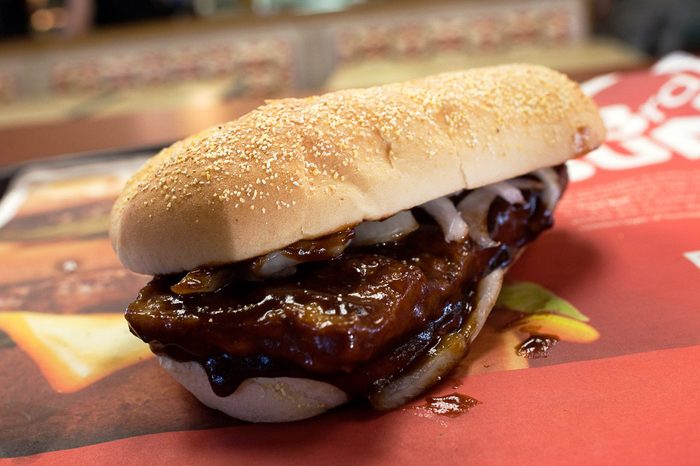
The McRib’s infamous ingredient list
Rumor: The seasonal McRib sandwich is made using over 70 (yes, 70!) ingredients, some of which are highly questionable.
Fact-check: False—but it was true at one point.
The McRib’s ingredient list sent shock waves through the internet in the early 2010s, with everyone from The Week to Time claiming that it contained more than 70 ingredients. And at that time, it did. Perhaps surprisingly, nearly half of those were in the bun.
And it wasn’t just the jarring number that shocked McRib lovers—it was some of the ingredients themselves. The most noteworthy was azodicarbonamide, which, although considered safe to use by the FDA, did make the public uneasy; the flour-bleaching agent is also used in foam products like yoga mats. Following this coverage and people’s growing distrust, McDonald’s trimmed down its McRib recipe. Today, the seasonal sandwich is made with about 40 ingredients—still an extensive list, with a whole lot in the bun—but no longer contains questionable ingredients like azodicarbonamide.
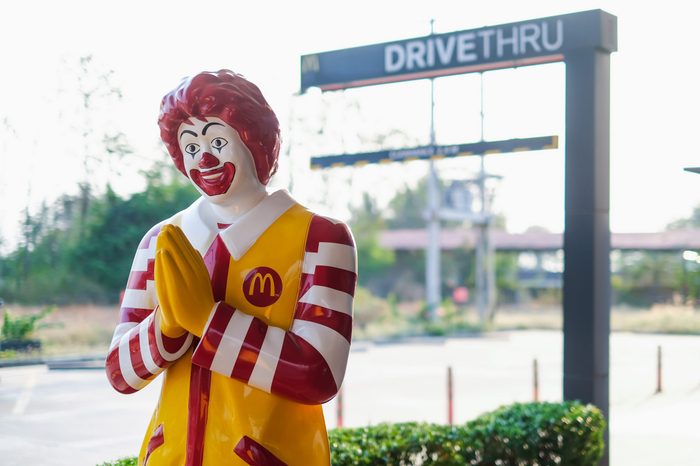
McDonald’s secret menu
Rumor: McDonald’s has a secret menu with rare items that are not accessible at every restaurant.
Fact-check: True!
Secret menus are very much real and not just a McDonald’s urban legend you grew up with. These are in their heyday, with people across the internet sharing menu hacks for their favorite fast-food restaurants. (Which kind of takes away from the “secret” descriptor, but that’s beside the point.)
McDonald’s has a few lesser-known “off-the-menu” items that you’ll see pop up occasionally while scrolling through FoodTok. One is the “Poor Man’s Big Mac,” basically a McDouble with Big Mac sauce and extra condiments. Another is the “Chicken McGriddle,” a crispy chicken patty between soft and warm syrup-soaked McGriddle cakes. However, the secret menu is “secret” and therefore unofficial. So there’s a solid chance options and availability may differ from one McDonald’s to the next, and the staff may not always be familiar with the secret lingo. If you’re going to order off the secret menu, our suggestion is to go equipped with an explanation of what the item consists of.

McDonald’s less-than-hygienic ball pits
Rumor: In the late 1990s, a 3-year-old child died after being accidentally pricked by a discarded needle while playing in the McDonald’s ball pit.
Fact-check: False
The unexplored depths of the ball pits in McDonald’s indoor PlayPlaces made people imagine the worst. And honestly, they can be pretty gross! But this particular McDonald’s news, which claimed a 3-year-old boy died of an accidental heroin overdose after encountering a discarded needle in the ball pit, was nothing but a hoax, as verified by fact-checking website Snopes.
That doesn’t mean health and safety concerns about McDonald’s PlayPlaces—or fast food play areas in general—aren’t justified, though. Those cramped ball pits and tube tunnels have been subject to serious scrutiny from concerned parents and health organizations after many confirmed reports of hygiene issues were brought to light. Multiple Reddit threads blame the cramped nature of these play areas for their rare upkeep.

The taste of McDonald’s Coca-Cola
Rumor: The Coca-Cola at McDonald’s tastes different than the soda at other restaurants.
Fact-check: True!
Have you ever felt like Coca-Cola at McDonald’s just tastes better? Well, it’s not just in your head! The “better” taste that so many of us love has to do with how McDonald’s prepares its soda. Most fast-food joints that serve Coke prepare the beverage in-house using Coca-Cola’s signature syrup. While the soda recipe is the same at McDonald’s as everywhere else, the fast-food chain has a unique process of pre-chilling the soda, which aids the carbonation process by keeping the liquids (water and syrup) cool from the get-go, ultimately making it a better-tasting Coke.
“The water and Coca-Cola syrup are pre-chilled before entering our fountain dispensers with the ratio of syrup set to allow for ice to melt,” the company’s FAQ page says. This set ratio further ensures that the melting ice is just the right amount so that your soda doesn’t feel watered down and remains as flavorful as possible. So the next time someone asks which fast-food joint serves the most refreshing Coke, you know that McDonald’s is the right answer.

McDonald’s (milk)shakes
Rumor: McDonald’s shakes contain no milk at all.
Fact-check: False
For firm believers of this McDonald’s rumor, the name of the drink is a red flag. After all, they reason, why would McDonald’s call them “shakes” and not “milkshakes” unless the company legally couldn’t use the term milkshake because they contained no milk? With that foregone conclusion, people started making the wildest speculations about what was actually in these creamy dessert drinks. From chicken feathers to Styrofoam, the guesses were outlandish at best.
However, this unfounded fast-food rumor—which has been periodically popping up since the ’60s—is false. Despite the name, the primary ingredient in McDonald’s shakes is reduced-fat soft-serve ice cream, which has milk as the primary ingredient. So why the ambiguous name? According to McDonald’s, it’s because different states have different requirements for what can be called milkshakes. For example, New York does not allow beverages with less than 3.25% milk fat to be considered milkshakes. On the other hand, California places more weight on the actual milk content in the beverage. So McDonald’s just calls them shakes to avoid any state-to-state confusion—not because it’s a sugary mix of crushed Styrofoam! Other notable fast-food brands that also market their milkshakes as shakes include Burger King and Sonic.

The beef with McDonald’s fries
Rumor: McDonald’s lied about using beef products in its fries.
Fact-check: False—on a technicality
McDonald’s never lied about the animal products used to make its fries, but it never outwardly said the fries weren’t vegetarian either. First things first: No, the fries are not vegetarian or vegan. In 1990, McDonald’s stopped cooking its fries in beef fat and switched to vegetable oil—and that’s where the confusion arose. This publicized swap understandably made people think the fries were indeed vegetarian. But this “vegetable oil” still contained the “essence of beef” to flavor the fries.
After several separate lawsuits from vegetarians—two of whom were Hindu and abstained from eating beef products for religious reasons—McDonald’s issued an apology. At first, the food giant claimed that it had never outwardly labeled its fries as vegetarian. Eventually, the company owned up to making misleading claims amid a growing public uproar. “We regret we did not provide these customers with complete information, and we sincerely apologize for any hardship that these miscommunications have caused,” a 2002 statement on the company’s site said.
McDonald’s agreed to pay $10 million to various Hindu and other groups. It may not have been an outright lie, but this fast-food scandal rocked the industry and McDonald’s Hindu consumer base in the early 2000s. Following this, McDonald’s decided to ramp up variations in its global menus to better cater to people of all beliefs and faiths. For example, the fries in India (a Hindu-majority country) are 100% vegetarian, with no beef essence for added flavor.
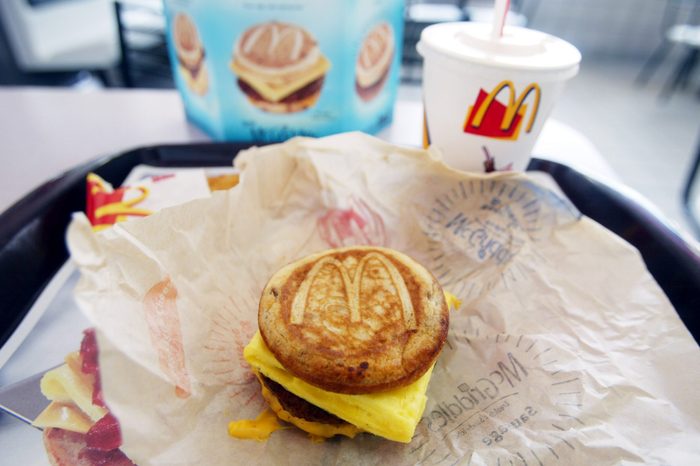
Eggs in McDonald’s breakfast dishes
Rumor: Breakfast items at McDonald’s do not use real eggs.
Fact-check: True—if by “real eggs,” you mean “freshly cracked eggs”
Only one of McDonald’s breakfast dishes uses freshly cracked eggs, and that’s the Egg McMuffin. So what do the other dishes use? Well, they’re still eggs; they’re just not exactly cracked fresh. Most of the breakfast sandwiches contain what’s known as a folded egg. These are “liquid eggs that are precooked and folded,” McDonald’s website states.
These folded eggs also contain other stuff—specifically, nonfat milk, modified food starch, salt and citric acid. After cooking and folding the eggs, McDonald’s suppliers “flash-freeze” them, and they’re sent, frozen, to McDonald’s kitchens. So technically, they are real eggs, but they’re not just eggs, and they’re certainly not fresh eggs. If you’d prefer 100% fresh eggs, ask specifically for a “round egg” on your sandwich, a McDonald’s employee revealed on Quora.
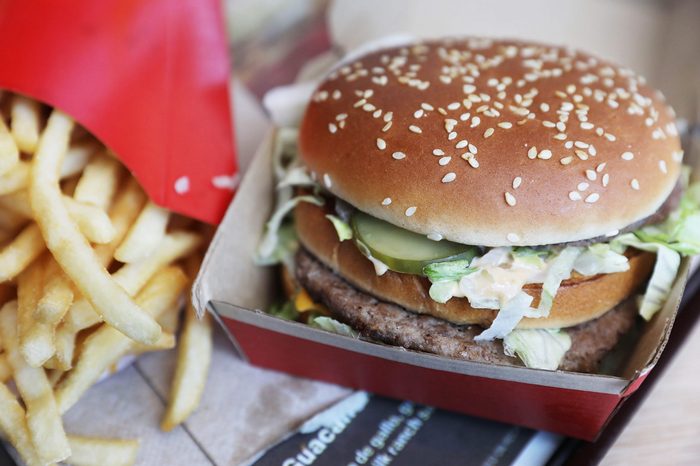
McDonald’s chemically preserved burgers
Rumor: McDonald’s hamburgers are so full of chemicals that they won’t rot (even after years!).
Fact-check: False
This McDonald’s rumor took off in 2008, when a woman shared a photo of a McDonald’s hamburger she’d had for 12 years that looked eerily indistinguishable from a fresh one. “People always ask me, ‘What did you do to preserve it?’ Nothing—it preserved itself,” she wrote on her blog, labeling the burger “a chemical food.” Similar posts continued to crop up and spark heated debates about McDonald’s food. Most argued that the reason why McDonald’s food wouldn’t go bad like actual food was because it was so full of chemicals. But the proposed science in these posts just didn’t add up.
Serious Eats writer and cookbook author J. Kenji López-Alt did a controlled experiment and shared his findings, which refuted the “chemical food” claims and explained the science behind this puzzling phenomenon. What he found was that the reason the burgers weren’t going bad was that they were drying out before they could rot. And spoiler alert (literally): All burgers will do that, as will many other foods.
Furthermore, part of the reason for the longevity of this burger was that it was a regular ol’ McDonald’s hamburger. “A McDonald’s hamburger is small and thin … cooked well-done on a very hot griddle,” López-Alt explained. “These factors contribute to rapid moisture loss, resulting in a burger that dries out long before it can start to rot.” On the other hand, larger McD’s burgers, like the Quarter Pounder, do show signs of rot before they dry out, simply because it takes them a little longer to lose moisture.
Why trust us
At Reader’s Digest, we’re committed to producing high-quality content by writers with expertise and experience in their field in consultation with relevant, qualified experts. We rely on reputable primary sources, including government and professional organizations and academic institutions as well as our writers’ personal experiences where appropriate. We verify all facts and data, back them with credible sourcing and revisit them over time to ensure they remain accurate and up to date. Read more about our team, our contributors and our editorial policies.
Sources:
- Internet Archive Way Back Machine: “McDonald’s Statement on Discontinued Use of Select Lean Beef Trimmings”
- Associated Press: “McDonald’s no longer uses ‘pink slime,’ despite rumors”
- McDonald’s: FAQ Page on “Does McDonald’s use ‘pink slime’ in burgers or beef treated with ammonia?”
- U.S. Food & Drug Administration: “Substances Added to Food: Carrageenan”
- The Week: “What’s the McRib made of, anyway?”
- Time: “Why Lovin’ the McRib Isn’t Heart Smart”
- U.S. Food & Drug Administration: “Azodicarbonamide (ADA) Frequently Asked Questions”
- Snopes: “Heroin Needle in the Ballpit”
- McDonald’s: “Why does Coca-Cola taste so good at McDonald’s?”
- McDonald’s: “Why don’t you call your ‘shakes,’ ‘milkshakes’?”
- Thomson Reuters Westlaw: “Unofficial New York Codes, Rules and Regulations: Milk Control”
- CBS News: “McDonald’s Settles Beef Over Fries”
- McDonald’s: “Does McDonald’s use Freshly Cracked Eggs?”
- McDonald’s: “How are McDonald’s Eggs Prepared?”
- Quora: “What are some favorite McDonald’s hacks?”
- Best of Mother Earth: “1996 McDonalds Hamburger”
- Serious Eats: “Here’s Why McDonald’s Burgers Don’t Rot | The Food Lab”




















